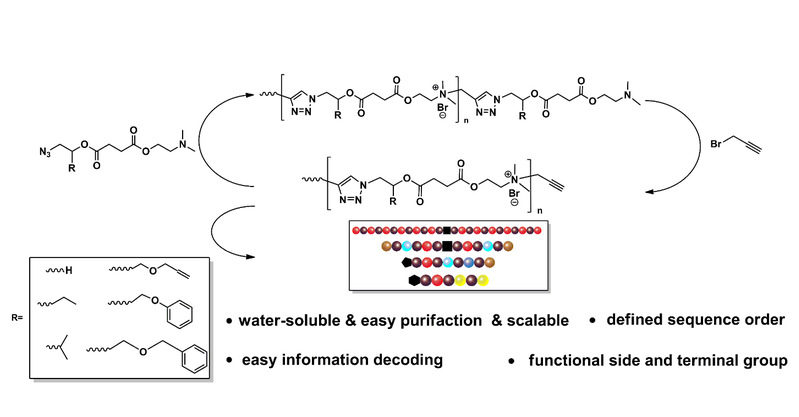Scientists Develop A New Method to Synthesize Positively Charged Sequence-defined Polymers
Time: 2019-04-10 visit times :8
Synthesizing artificial sequence-defined macromolecules is an important issue in polymer science. Among previous reports, most of the existing artificial sequence-defined polymers are uncharged, part polymers imitating DNA are negatively charged, with polyphosphate backbone or amine backbone. To date, no report on synthesizing monodisperse polymers with positively charged backbone of quaternary ammonium has been published, mainly due to the difficulties of molecular design, synthesis, and characterization.
Well, sequence-defined polymers with positively charged backbone offer water-soluble property, resulting in a great advantage in bioapplications compared with existing water-insoluble sequence-defined polymers. Furthermore, well-defined cationic polymers can precisely interact with negatively charged DNA and siRNA, leading to a controllable effect in gene transfection and drug delivery. Therefore, synthesizing cationic sequence-defined polymers is of great significance.
A team headed by Prof. Chao Gao, director of the Institute of Polymer Science in the Department of Polymer Science and Engineering (DPSE), developed a new polar-inverse strategy (PIS) for scalable synthesizing sequence-defined polymers with positively charged backbone by alternately processing Menschutkin reaction and Cu-catalyzed azide–alkyne cycloaddition (CuAAC) reaction.
This method offers extremely high yields (average yield >95% for each step), favoring cost-effective large-scale production (reaction can be achieved in grams). Because of the independent reactivity of selected functional groups, the cationic sequence-defined polymers are highly programmable, including backbone composition, sequence order, functional side groups, terminal groups and topological structure. Due to the dramatic polarity difference between weak polar feed molecules and strong polar target molecules, simple precipitation in weak polar solvents is enough to obtain pure sequence-defined polymers.

In this work, polymers with up to 12 positive ions and 4800 Da were synthesized and characterized. Employing six different side group functionalized monomers and three different starting units, eight series of polymers with different sequence orders were synthesized in high yields. Moreover, researchers studied the decoding method of the cationic polymers by analyzing the Maldi-Tof MS spectra of different sequences. According to the fragmentation mechanism, the only two things needed to know for decoding the sequences are the starting unit and monomer alphabet. The sequence information can be simply “readed” by calculating the gap between two fragment peaks without recourse to the synthetic history. No complicated algorithm is required and all single-charged fragments result in no deconvolution, leading to a high resolution.
Specifically speaking, mass spectrum (MS) measurement for cationic polymers is a big challenge. In this case, polymers with multiply bromine anions gave no analyzable peak in all kinds of mass spectra, mainly caused by the instability of the quaternary ammonium bond and the tendency to form multiply charged fragments while characterizing. For increasing stability of onium ions to observe molecular ion peak and single charged fragment peaks clearly in matrix-assisted laser desorption / ionization time-of-flight mass spectrometry (Maldi-Tof MS), we employed lithium bis ( trifluoromethane sulfonimide ) ( LiTf2N ) to exchange the bromide anions of polymers. In subsequent Maldi-Tof MS measurements, the molecular ion peak ([Px+[Tf2N–]x−1]+, wherein P represents the main part of polymer) of each sequence-defined polymer and fragment peaks caused by rupture of quaternary ammonium bond were observed clearly. Furthermore, The combination of SEC, Maldi-Tof MS, nuclear magnetic resonance (NMR), and infrared (IR) spectroscopy measurements confirmed the fine structures of cationic functional sequence-defined polymers.

“Our research enables cost-effective large-scale production of multifunctional positively charged polymers, paving the way to their applied research and real applications, such as gene transfection and drug delivery. It’s a good start.”Prof. Chao Gao said. This work was published in Journal of the American Chemical Society (JACS) .
Written by Cong Chen
Zhe Da Road 38, Hangzhou 310027, China
Tel : 86-571-87951308
Fax : 86-571-87951592
Email : ciciliu33@zju.edu.cn